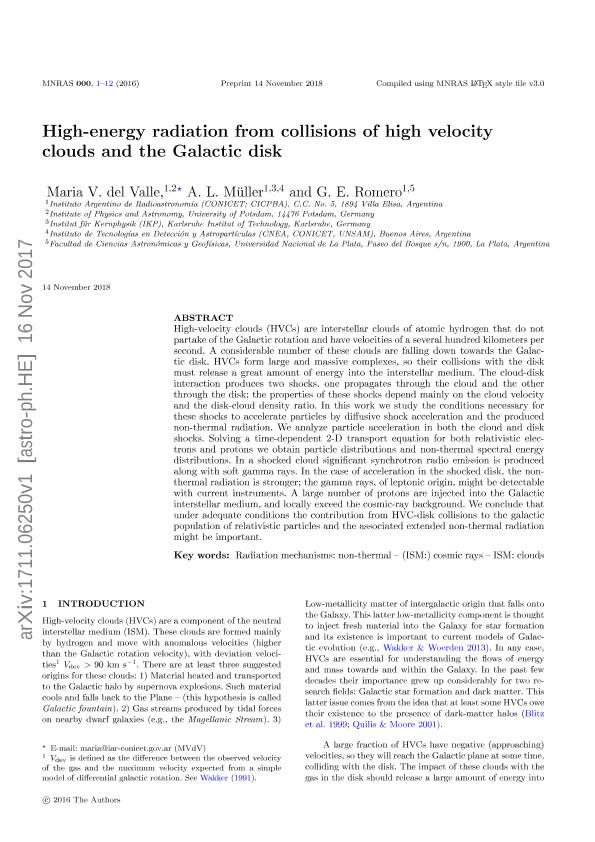Artículo
High-energy radiation from collisions of high-velocity clouds and the Galactic disc
Fecha de publicación:
04/2018
Editorial:
Oxford University Press
Revista:
Monthly Notices of the Royal Astronomical Society
ISSN:
0035-8711
Idioma:
Inglés
Tipo de recurso:
Artículo publicado
Clasificación temática:
Resumen
High-velocity clouds (HVCs) are interstellar clouds of atomic hydrogen that do not follow normal Galactic rotation and have velocities of a several hundred kilometres per second. A considerable number of these clouds are falling down towards the Galactic disc. HVCs form large and massive complexes, so if they collide with the disc a great amount of energy would be released into the interstellar medium. The cloud-disc interaction produces two shocks: one propagates through the cloud and the other through the disc. The properties of these shocks depend mainly on the cloud velocity and the disc-cloud density ratio. In this work, we study the conditions necessary for these shocks to accelerate particles by diffusive shock acceleration and we study the non-thermal radiation that is produced. We analyse particle acceleration in both the cloud and disc shocks. Solving a time-dependent two-dimensional transport equation for both relativistic electrons and protons, we obtain particle distributions and non-thermal spectral energy distributions. In a shocked cloud, significant synchrotron radio emission is produced along with soft gamma rays. In the case of acceleration in the shocked disc, the non-thermal radiation is stronger; the gamma rays, of leptonic origin, might be detectable with current instruments. A large number of protons are injected into the Galactic interstellar medium, and locally exceed the cosmic ray background. We conclude that under adequate conditions the contribution from HVC-disc collisions to the galactic population of relativistic particles and the associated extended non-thermal radiation might be important.
Palabras clave:
Cosmic Rays
,
Ism: Clouds
,
Radiation Mechanisms: Non-Thermal
Archivos asociados
Licencia
Identificadores
Colecciones
Articulos(IAR)
Articulos de INST.ARG.DE RADIOASTRONOMIA (I)
Articulos de INST.ARG.DE RADIOASTRONOMIA (I)
Citación
del Valle, Maria V.; Müller, A. L.; Romero, Gustavo Esteban; High-energy radiation from collisions of high-velocity clouds and the Galactic disc; Oxford University Press; Monthly Notices of the Royal Astronomical Society; 475; 4; 4-2018; 4298-4308
Compartir
Altmétricas




